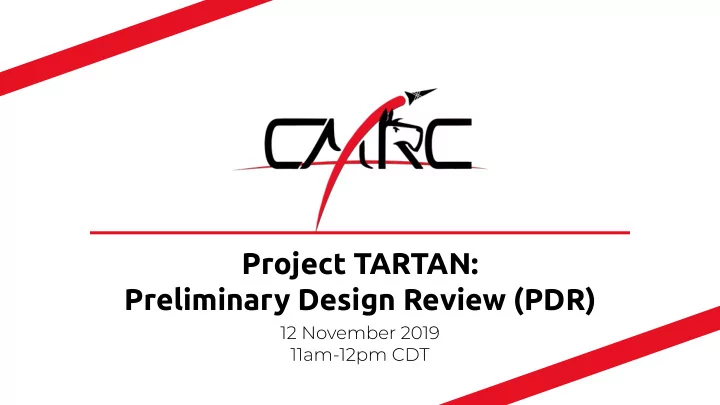

Project TARTAN: Preliminary Design Review (PDR)
Vehicle Summary: Dimensions and Materials Parameter Value Length 121” Outer Diameter 6.112” Inner Diameter 6” Materials Carbon Fiber / G12 Fiberglass Mass Dry: 454 oz Wet: 584 oz 2
Vehicle Summary: Stability Margin Parameter Value Static Stability Margin 2.63 CP (from Nose Cone) 93.874” CG (from Nose Cone) Dry: 73.076” Wet: 77.797” 3
Vehicle Summary: Motor & Launch Considerations Motor: Aerotech L830W Apogee with L850W: 5,762 ft Bring down to 5,280 using ● Apogee Targeting System Rationale: Apogee with ballast within ● range of ATS correction 5,400-6,000ft ○ 4
Launch 1. Nose Cone and Airframe 2. Payload and Payload Vehicle Deployment 3. Recovery Overview 4. ATS & Motor Retention 5
Launch Vehicle Schematic { { { { Nose Cone Payload & Recovery Payload Deployment ATS & Motor Mount System 6
Vehicle Alternative Designs: Nose Cone Fiberglass vs. Carbon Fiber ● Public Missiles vs. Madcow ● Considerations ● Size ○ Price ○ Compatability with Electronics ○ Unintentional RF Shielding ○ 7
Vehicle Alternative Designs: Airframe Materials ● G10/G12 Fiberglass vs Carbon Fiber ○ Benefits to Carbon Fiber ● Stronger → Thinner Airframe → Lighter ○ Drawbacks to Carbon Fiber ● Expensive ○ Difficult to work with ○ 8
Launch Vehicle Schematic { { { { Nose Cone Payload & Recovery Payload Deployment ATS & Motor Mount System 9
Payload: Rover Two-Wheeled Option Four-Wheeled Option With Auger With Reversible Scoop 10
Payload: Deployment Payload with spring loaded deployment mechanism Locking Mechanism to prevent premature firing 11
Launch Vehicle Schematic { { { { Nose Cone Payload & Recovery Payload Deployment ATS & Motor Mount System 12
Recovery: Recovery Bay Recovery Bay ● RF Shielding: Aluminum Shield Tape ○ Additive Aerospace Sled vs Made-In-House ○ Materials: PLA vs. Acrylic vs. Aluminum ■ Electronics ○ Leading Altimeter: PerfectFlite Stratologger CF ■ Independent Systems ■ Duracell 9V Battery ■ 13
Recovery: Redundant Systems 14
Recovery: Parachutes Drogue ● SkyAngle Classic I 24” ○ Terminal Velocity: 94.1 ft/s ○ Main ● FruityChute Iris Ultra 96” ○ Terminal Velocity: 16.4 ft/s ○ Maximum Landing Kinetic Energy: 65.28 ft-lbs ○ 15
Recovery: GPS Telemetry Location: Payload Deployment Bay (Fiberglass) ● 19” away from nearest e-match in main parachute bay ○ Will use RF shielding to prevent premature deployment of main ○ parachute Model: BigRedBee 70cm 100mW GPS/APRS Transmitter ● Can transmit on any frequency in 125 Hz steps ○ 16
Launch Vehicle Schematic { { { { Nose Cone Payload & Recovery Payload Deployment ATS & Motor Mount System 17
Apogee Targeting System (ATS) Overview The ATS is an airbrake system designed to regulate the velocity of ● the rocket in flight. It consists of a set of four motor flaps that extend from the sides of ● the rocket to generate drag, slowing the rocket to ensure that it achieves the target apogee of 5280 ft. The extension of the flaps is determined by a control algorithm that ● uses data from an altimeter system and an inertial measurement unit. 18
ATS Physical Design The air brake deployment system consists ● of a central rotation hub, the attached rotation piece, 4 connecting arms, 4 flaps, and 4 flap guides. Our current flap design is a rectangular ● shaped flap with a curved outer edge. While similar to our first flap design, this ● flap has the key advantage of having extra surface area and endure more force. 19
ATS Algorithm Design The algorithm begins collecting data after motor burnout. ● The system will average measurements of multiple sensors or utilize ● a Kalman filter to clean the data. Drag force is calculated based on measured velocity and current flap ● extension. Based on the drag force, the current altitude, and the velocity the ● system will predict the estimated apogee. After apogee calculation, the system adjusts flap extension ● accordingly, feeds back the data, and repeats the process. 20
Motor Retention System Thrust Plate ● 6061 vs 7075 ○ Thickness ○ Easy to manufacture ○ CNC Capabilities ○ 75mm flanged motor retainer and ● cap Very hard to manufacture ○ Reliable ○ 21
Mission 1. Apogee Performance 2. Kinetic Energy & Descent 3. Drift Predictions 22
Apogee Overall goal: 5,280 ft ● Current Apogee w/ L850W & no ballast: 5,762 ft ● Ballast to bring apogee within a few hundred feet of goal ○ ATS brings it down to actual goal ○ 23
Kinetic Energy & Descent Landing Kinetic Energy ● Upper: 44.5 ft-lbs ○ Middle: 51.87 ft-lbs ○ Lower: 65.28 ft-lbs ○ RasAero Simulation: ● Descent Time: 83s ○ 24
Drift OpenRocket Simulations ● Max 1,790ft ○ 20mph launching ○ downwind 25
Quick update: Most requirements pertain ● to design of rocket and its Requirements design process. Requirements are kept in ● Verification mind during design process Internal design stop: ● December 6th 26
Questions?
Recommend
More recommend